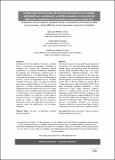| dc.contributor.author | Mora Campos, Andrea | |
| dc.contributor.author | Ramírez Ulloa, Juan José | |
| dc.contributor.author | Hernández Chacón, Milena | |
| dc.date.accessioned | 2020-05-05T16:20:41Z | |
| dc.date.available | 2020-05-05T16:20:41Z | |
| dc.date.issued | 2020-06 | |
| dc.identifier.issn | 2313-9927 | |
| dc.identifier.uri | http://hdl.handle.net/11056/17277 | |
| dc.description.abstract | Comparación de los niveles de burnout, actividad física y somatización en docentes. Participan 94 docentes del sistema de educación pública costarricense, en distintas modalidades educativas. Se utilizaron tres instrumentos: CESQT-Burnout, la CISSQT-Somatización y el IPAQ-Activida física. La normalidad de los datos se evaluó con Kolmogorov Smirnov Test, la homogeneidad de las varianzas mediante el Test de Levene. Se realizaron ANOVA para grupos independientes de 10 vías, con un alfa fijado de 5 %. Hubo diferencias estadísticamente significativas en la variable somatización entre colegio académico (14,22 ± 9,49 puntos) y laboratorio (29,29 ± 11,32 puntos) y entre la categoría “De 10 hasta 25 lecciones” (20,88 ± 19,71 puntos) y “De 41 hasta 60 lecciones” (21,22 ± 12,76 puntos). Hubo correlación positiva (p < 0,05; r = ,589), entre somatización y burnout. Profesores de colegio laboratorio presentan mayores niveles de somatización que el colegio académico. | es_ES |
| dc.description.abstract | This research was carried out with the participation of 94 teachers from the Costa Rican public education system; from four different types of secondary schools. Three instruments were used in this study: CESQT-Burnout; CISSQT-Somatizationand IPAQ-Physical Activity. The normality of the data was evaluated using the Kolmogorov-Smirnov test, and the homogeneity of variances was evaluated using the Levene Test. A 10-way ANOVA was performed for independent groups, with a fixed alpha of 5%. There were statistically significant differences in mean somatizationindex scores between academic teachers in academic schools (14.22 ± 9.49) and laboratory schools (29.29 ± 11.32) and between the "From 10 to 25 lessons" category (20.88 ± 19.71), and the "From 41 to 60 lessons" category (21.22 ± 12.76). A positive correlation (p <0.05, r =.589) was also found between somatization disorder and burnout. Teachers in laboratory schools show higher levels of somatization disorder than those in academic schools. | es_ES |
| dc.description.sponsorship | Universidad Nacional, Costa Rica | es_ES |
| dc.language.iso | spa | es_ES |
| dc.publisher | Universidad Nacional del Centro de la Provincia de Buenos Aires | es_ES |
| dc.rights | Acceso abierto | es_ES |
| dc.rights | Atribución 4.0 Internacional | * |
| dc.rights.uri | http://creativecommons.org/licenses/by/4.0/ | * |
| dc.source | REVISTA ESPACIOS EN BLANCO vol.1 no.30 129-146 2020 | es_ES |
| dc.subject | BURNOUT (PSICOLOGÍA) | es_ES |
| dc.subject | TRASTORNO DE SOMATIZACIÓN | es_ES |
| dc.subject | ACTIVIDAD FÍSICA | es_ES |
| dc.subject | ENSEÑANZA PRIMARIA | es_ES |
| dc.subject | SOMATIZATION DISORDER | es_ES |
| dc.subject | PHYSICAL ACTIVITY | es_ES |
| dc.subject | PRIMARY EDUCATION | es_ES |
| dc.subject | BURNOUT (PSYCHOLOGY) | |
| dc.title | Comparación de los niveles de burnout (quemarse por el trabajo), actividad física, somatización y variables sociales, en docentes de diferentes modalidades de educación secundaria en Costa Rica | es_ES |
| dc.type | http://purl.org/coar/resource_type/c_6501 | es_ES |
| dc.description.procedence | Vicerrectoría de Investigación | es_ES |
| dc.identifier.doi | https://doi.org/10.37177/UNICEN/EB30-268 | |


